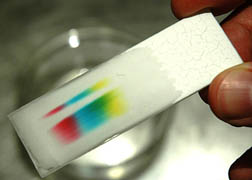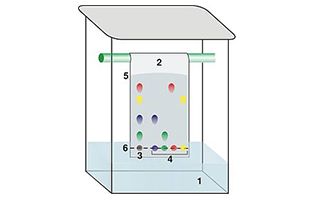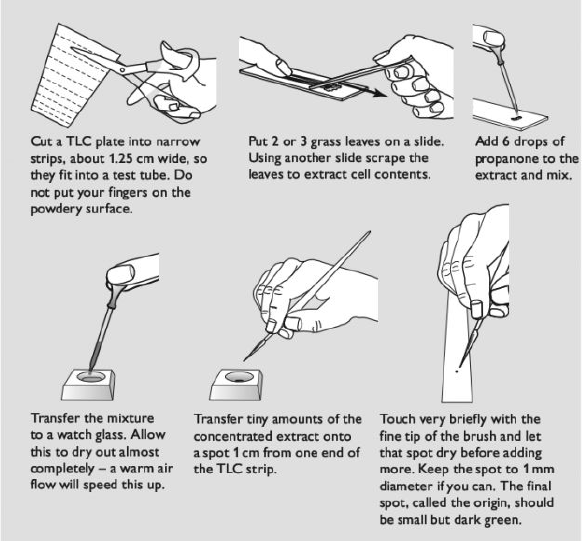Biology
 Chromatography is a method of separation that relies on the different solubilities of different solutes in a solvent. A mixture of chlorophyll pigments is dissolved in a solvent, and then a small spot is placed onto chromatography paper. The solvent gradually moves up the paper, carrying the solutes with it. The more soluble the solvent, the further up the paper it is carried.
Chromatography is a method of separation that relies on the different solubilities of different solutes in a solvent. A mixture of chlorophyll pigments is dissolved in a solvent, and then a small spot is placed onto chromatography paper. The solvent gradually moves up the paper, carrying the solutes with it. The more soluble the solvent, the further up the paper it is carried.
Paper chromatography is a useful technique in the separation and identification of different plant pigments.

The distance traveled by a particular compound can be used to identify the compound. The ratio of the distance traveled by a compound to that of the solvent front is known as the Rf value; unknown compounds may be identified by comparing their Rf's to the Rf's of known standards.
Rf equation:


Only an outline of the procedure is given here, so you cannot use these instructions to actually carry out the experiment.


Video TLC
- #103 The Light-independent Reactions (calvin Cycle)
The light-independent reactions take place in the stroma of the chloroplast, where the enzyme ribulose bisphosphate carboxylase, usually known as rubisco, is found. 1. Carbon fixation CO2 diffuses into the stroma from the air spaces within the...
- # 102 The Light-dependent Reactions, Photophosphorilation
Chlorophyll molecules in photosystern I (PSI) and photosystern II (PSII) absorb light energy. The energy excites electrons, raising their energy level so that they leave the chlorophyll. The chlorophyll is said to be photo-activated. PSII contains...
- #101 Photosynthetic Pigments
Photosynthetic pigments are pigments presented in chloroplasts or photosynthetic bacteria. They capture light energy necessary for photosynthesis and convert it to chemical energy. PigmentsA pigment is any substance that absorbs light.The color...
- #100 Chloroplasts
Photosynthesis takes place inside chloroplasts. These are organelles surrounded by 2 membranes, called an envelope. Chloroplasts are found in mesophyll cells in leaves: - Palisade mesophyll cells contain most chloroplasts. - Spongy...
- #98 Photosynthesis Syllabus
13.1 Photosynthesis as an energy transfer process 13.2 Investigation of limiting factors 13.3 Adaptations for photosynthesis Photosynthesis is the energy transfer process that is the basis of much of life on Earth....
Biology
#104 Separating chlorophyll pigments by Thin layer chromatography (TLC)

Paper chromatography is a useful technique in the separation and identification of different plant pigments.
- In this technique, the mixture containing the pigments to be separated is first applied as a spot or a line to the paper about 1.5 cm from the bottom edge of the paper.
- The paper is then placed in a container with the tip of the paper touching the solvent. Solvent is absorbed by the paper and moves up the paper by capillary action.
- As the solvent crosses the area containing plant pigment extract, the pigments dissolve in and move with the solvent.
- The solvent carries the dissolved pigments as it moves up the paper. The pigments are carried along at different rates because they are not equally soluble. Therefore, the less soluble pigments will move slower up the paper than the more soluble pigments. This is known as developing a chromatogram.
There are various methods. The one described here uses Thin layer chromatography (TLC) on specially prepared strips instead of paper. It is a chromatography technique for analyzing mixtures by separating the compounds in the mixture. TLC can be used to help determine the number of components in a mixture, the identity of compounds, and the purity of a compound. During chromatography, a mobile phase (eluent) distributes the compounds present in a mixture over a stationary phase (adsorbent).

The distance traveled by a particular compound can be used to identify the compound. The ratio of the distance traveled by a compound to that of the solvent front is known as the Rf value; unknown compounds may be identified by comparing their Rf's to the Rf's of known standards.
Rf equation:




Video TLC
Syllabus: 13.1 Photosynthesis as an energy transfer process Light energy absorbed by chloroplast pigments in the light dependent stage of photosynthesis is used to drive reactions of the light independent stage that produce complex organic compounds. Chromatography is used to identify chloroplast pigments and was also used to identify the intermediates in the Calvin cycle. a) explain that energy transferred as ATP and reduced NADP from the light dependent stage is used during the light independent stage (Calvin cycle) of photosynthesis to produce complex organic molecules b) state the sites of the light dependent and the light independent stages in the chloroplast c) describe the role of chloroplast pigments (chlorophyll a, chlorophyll b, carotene and xanthophyll) in light absorption in the grana d) interpret absorption and action spectra of chloroplast pigments e) use chromatography to separate and identify chloroplast pigments and carry out an investigation to compare the chloroplast pigments in different plants (reference should be made to Rf values in identification) f) describe the light dependent stage as the photoactivation of chlorophyll resulting in the photolysis of water and the transfer of energy to ATP and reduced NADP (cyclic and non-cyclic photophosphorylation should be described in outline only) g) outline the three main stages of the Calvin cycle: ? fixation of carbon dioxide by combination with ribulose bisphosphate (RuBP), a 5C compound, to yield two molecules of GP (PGA), a 3C compound ? the reduction of GP to triose phosphate (TP) involving ATP and reduced NADP ? the regeneration of ribulose bisphosphate (RuBP) using ATP h) describe, in outline, the conversion of Calvin cycle intermediates to carbohydrates, lipids and amino acids and their uses in the plant cell |
- #103 The Light-independent Reactions (calvin Cycle)
The light-independent reactions take place in the stroma of the chloroplast, where the enzyme ribulose bisphosphate carboxylase, usually known as rubisco, is found. 1. Carbon fixation CO2 diffuses into the stroma from the air spaces within the...
- # 102 The Light-dependent Reactions, Photophosphorilation
Chlorophyll molecules in photosystern I (PSI) and photosystern II (PSII) absorb light energy. The energy excites electrons, raising their energy level so that they leave the chlorophyll. The chlorophyll is said to be photo-activated. PSII contains...
- #101 Photosynthetic Pigments
Photosynthetic pigments are pigments presented in chloroplasts or photosynthetic bacteria. They capture light energy necessary for photosynthesis and convert it to chemical energy. PigmentsA pigment is any substance that absorbs light.The color...
- #100 Chloroplasts
Photosynthesis takes place inside chloroplasts. These are organelles surrounded by 2 membranes, called an envelope. Chloroplasts are found in mesophyll cells in leaves: - Palisade mesophyll cells contain most chloroplasts. - Spongy...
- #98 Photosynthesis Syllabus
13.1 Photosynthesis as an energy transfer process 13.2 Investigation of limiting factors 13.3 Adaptations for photosynthesis Photosynthesis is the energy transfer process that is the basis of much of life on Earth....
